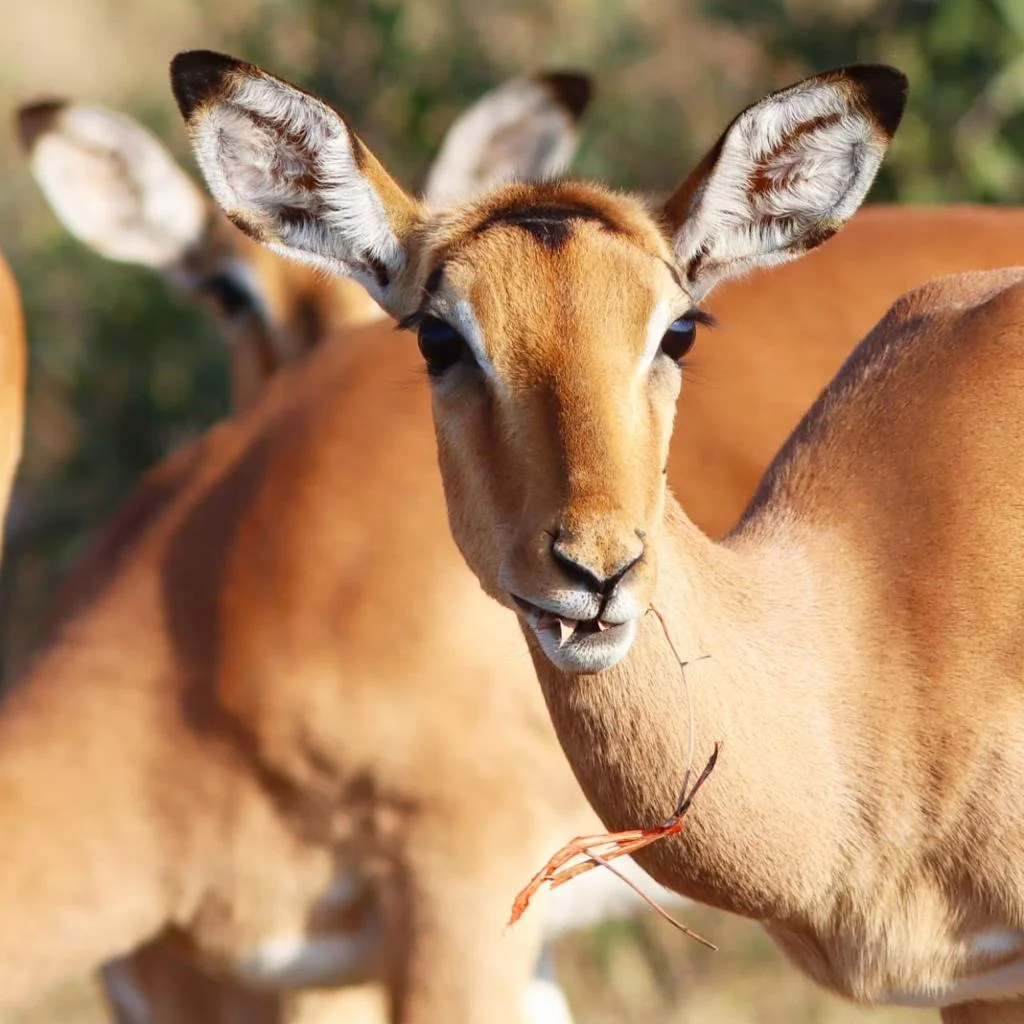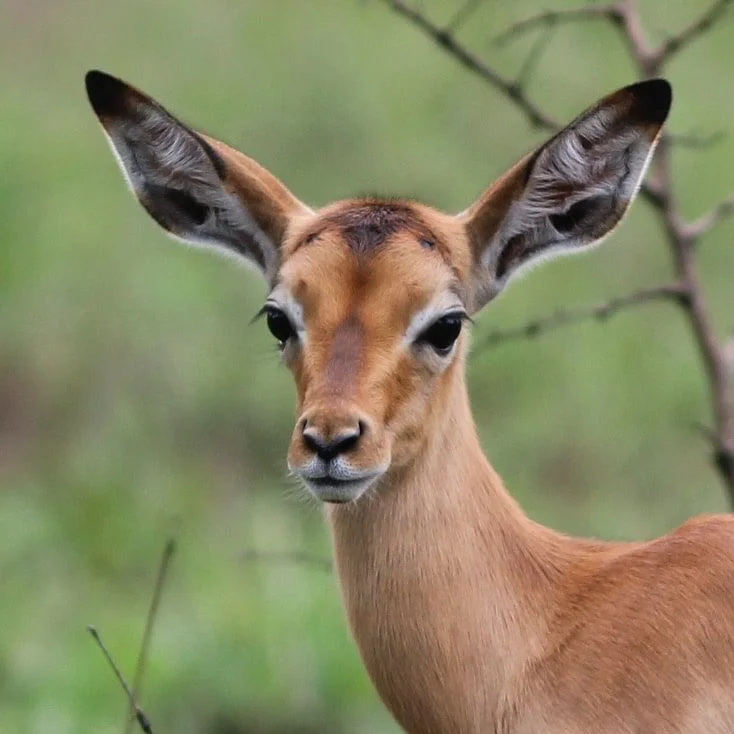
Aepyceros melampus
Lifespan : 6 – 12 years
Weight : 40 – 50 Kg
Height : 900 cm
Gestation : 6.5 months
The impala is found all over the Kruger park with an estimated population of one hundred and sixty five thousand making it the most populous Antelope. Many guests will ask if we have Gazelles in the park, the answer is no we do not have any gazelle in South Africa although the Springbok is the closest comparison to a Gazelle that we have. So what is the difference between an Antelope and a Gazelle? Basically all Gazelles are Antelopes but not all Antelopes are gazelles. Antelopes are members of the Bovidae family, this includes a huge variety of other antelope, wilderbeest, waterbuck, gazelle, oryx eland to name a few. Physically the gazelles are smaller than the antelopes and both the male and the females have horns. One of the differences that is visually very interesting that only gazelles do what is called stotting. When a predator is close by gazelles leap vertically into the air and as soon as they hit the ground they run off at full speed, although impalas do jump and zig zag away from predators they do not jump high and then run, the zig zagging makes it very difficult for the predators to catch the impalas and they generally save energy and give up, it is only a cheetah can outrun an impala.
The impala is probably the most overlooked animal in the park, there are so many of these beautiful antelope that it is the one animal we can guarantee that you will see! Their beauty is often ignored but, if you sit and spend time with them and watch their behaviour you can appreciate them. There are a lot of facts about impala that makes it an animal worthy of your “spotted” checklist. You might also enjoy reading facts about Giraffes and elephants.
Originally impala known as palla or pallah, from the Tswana word meaning red antelope, then in 1875 it was changed to impala or mpala. It is the only member of the genus Aepyceros , the name is derived from greek latin aipus meaning “high or steep “ and keras meaning “horn”, melampus meaning melas “ black foot” and pous meaning “ foot”.
When you look at how near perfect the design of the impala is, it adds more to actually how fascinating and near unique the impala actually is. Impalas developed from an alcelaphine ancestor, all the other bovines in the antelope family ie: wilderbeest etc ,theses antelopes that we see today have basically diverged morphologically at least 18 times over millions of years whereas the impala from fossil records have shown that the impala that we see today has not changed in 5 million years, the oldest of the fossils show that its ancestors were slightly smaller but apart from that there isn’t really a huge difference meaning that the impala didn’t need to adapt or change its appearance as it is literally perfect!
Impalas are found in two different types of groups, bachelor groups this will includes males of all ages and breeding groups that generally consist of adult females, young males and females andpossibly two adult males. When the breeding season starts young males will be kicked out of the group and they will then join bachelor herds.
Breeding time is synchronised with the first full moon of April ( Autumn ) and lasts roughly 3-4 weeks, with a very clever breeding strategy to avoid predation of the lambs born, during the mating (rutting) season ewes will be impregnated over the 3-4 week breeding window, not all of them are impregnated at the same time so this ensures that there are lambs born later so as to avoid huge losses to the lamb population. When the first set of newborns arrive it is a feast for the predators including, lions, leopards, cheetahs, wild dogs eagles, baboons and phythons, not all of them can be eaten so it will allow quite a large amount of lambs to develop.

Males are incredibly vulnerable to predation during this time as their main focus is on the group so in effect he neglects himself and can possibly become weaker as he doesn’t have time to groom himself of all the ticks (parasites) that build up and also uses a lot of energy mating with his harem along with all of this he has to fend off other males wanting to mate with his ewes so, he doesn’t have an easy time during the rutting season!
Fastidious about cleanliness the impalas are constantly grooming one another ( alogrooming ) they have a couple of loose lower incisors that act as a comb and they are constantly nibbling at their fur and also others. As with most of the mammals, ticks are a huge problem as they are a blood sucking parasite and will gradually weaken the mammal if not kept under control, so apart from grooming how does an impala get rid of these parasites that are found in the difficult to reach parts of the body? Oxpeckers play a vital role in controlling these parasites, they have a mutually beneficial relationship with mammals, it is not symbiotic as both parties do not need each other and it is not parasitic as neither is harmed by the relationship, an example of parasitic behaviour is a spider hunting wasp, the wasp benefits from paralysing the spider and laying its larvae in the spider therefore the spider does not benefit as he will eventually be eaten by the larvae, so mutually beneficial means that neither party is dependent on the other and nothing apart from the parasite is harmed. The oxpecker benefits as it gets plenty of food, it can also rest on the impala and they are often seen hitching a ride on the backs of the impalas and, they also pull out bits of the impalas fur that they use to line their nests with the impala will benefit from having the parasites removed and hence not succumbing to weakness due to blood loss.
Impalas have amazing senses that will alert them to danger. When feeding you will notice their eyes are placed on the side of their heads giving them peripheral vision, primates and predators along with a small antelope called a klipspringer have binocular vision. If impalas were to have binocular vision they wouldn’t be able to see what is creeping up on them as when they are grazing their heads are lowered, they do lift their heads to check the area but, by having peripheral vision they can graze and see if there is anything stalking them. Huge ears that are constantly moving listening for impending danger, humans ears are flattened against our heads so we can hear what is coming from the side, we are unable to move our ears and can only change our area of listening by moving our heads, the impala on the other hand can keep perfectly still and move its huge hears around. As the saying goes “ only prey runs “ so the impala can keep perfectly still if there is a predator around.
The term “ counter shading “ refers to a camouflage technique that the impala has. Imagine if you are a predator active at night due to your enhanced vision at night stalking an impala even with the advantage of better vision predators do not see in colour so the reason prey species have counter shading is due to the fact that they are breaking up their appearance to a predator. Impalas are a brownish/tan colour on top followed by a lighter shade of tan and then their under belly is white this will enable them to remain more difficult to see if they keep still.
The white underbelly also reflects the heat during summer as with most of the antelopes they are lighter underneath. Impala males scent mark using a scent gland in between the horns, this is used to mark their territories and they will do so by marking bushes, the males also defecate at middens, an area where they scent mark letting other males know they are in the area, another male can pass through this territory for water as long as he shows submissive behaviour and does not use the midden, a midden is basically a place where a male will defecate at the same spot to make his presence known and it is not unique to the impala, rhinos use middens to mark their territories.
Winter times in the Kruger can be quite chilly in the mornings so, how does an impala keep warm? The term is pilo erection. This is when the hair stands up and an amount of air is trapped close to their bodies enabling them to keep warm, you can see this in the winter as it makes the impalas fur look thicker and darker, it’s the equivalent of humans getting goose bumps on a cold day. Pilo erection is also used to make impalas look bigger to predators.

Predation of impalas is very high due to the amount of impalas in the park, when you think there are so many impalas to predators it is impossible for all of them to be eaten this is why it is important to have an equal balance of predator/prey species. By eating the impalas the population is kept under control making sure that over grazing and browsing is kept to a healthy level. Impalas have the advantage of being mixed feeders this means they can graze on the sweet grass of summer and browse leaves in the winter when there is a low density of grass. This is one of the factors that makes the impala so successful compared to other antelopes.
Although impalas are like I said very much overlooked they will help you find the predators, where there are impalas there are predators. They will spot the predator before us standind very close together and making a very loud snorting noise to alert the predator that he has been spotted!
Impalas are also becoming vital in the fight against poaching oddly enough and they will be used to help poaching activity within the park, how? Extensive research was done on herds of impalas in reserves that have no predators, the impalas were collared and humans entered the reserves, the data showed the reaction of the impalas to the presence of humans, heart rate, blood pressure etc. The impalas were then placed where there was a high concentration of predators again, the reaction of the impalas to the predators was recorded, this data will now be used on collared impalas and monitored by anti poaching units who will be able to tell if the impalas are reacting to human presence or the threat of a predator.
So really the impala that is often ignored is helping to protect our rhinos in the park and playing a vital role in saving another species.
